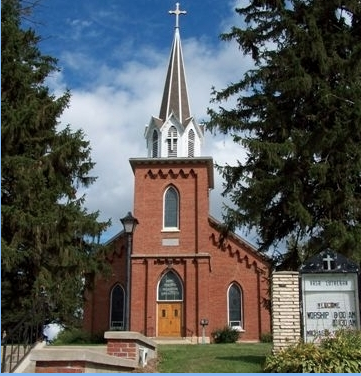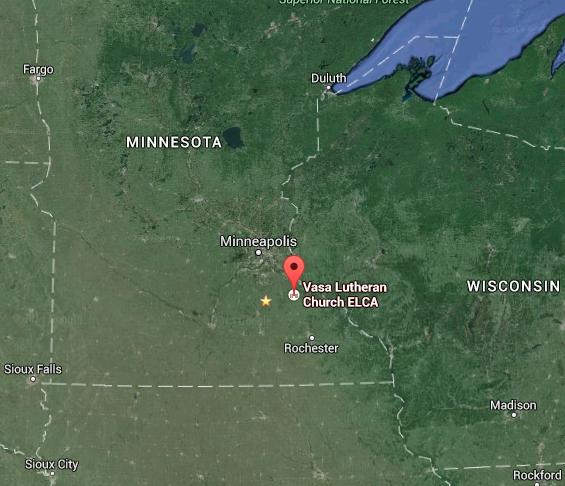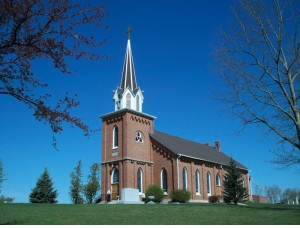
Current Vasa Lutheran Church Building

Vasa Ev. Lutheran Church, Welch, Goodhue County, Minnesota
Vasa Evangelical Lutheran Church is rich with exceptionally significant Lutheran history. Located in Welch, a small town in southeast Minnesota, the church is located on rolling hills of green. Like many other mid-western churches, Vasa Ev. was founded by immigrants who wanted to bring their religion and culture with them to the new world. This church was part of a larger geographical movement. When America was still developing its culture as a nation many people of Scandinavian descent settled the upper midwest, bringing with them a culture of Lutheranism. Vasa’s founders brought their religion to a new location, yet its purpose was not to convert people so much as Vasa was created to support the growth of an already Lutheran community. Serving a mostly rural population from its start, Vasa Lutheran has continued to grow and thrive.
Vasa Evangelical Lutheran Church was organized by a pastor named Eric Norelius in 1855. Norelius was born in Sweden and immigrated to the United States in 1850. The congregation that he started in Welch was first known as Swedish Lutheran Congregation. The name ‘Vasa’ eventually arose when Norelius suggested the church be named after the Swedish Royal family’s name at the time of the Reformation.
A few years later, Norelius undertook a feat that would greatly impact the future of a number of communities in America. In 1865, Norelius visited St. Paul and found four Swedish children who had just arrived with their parents in America. The children’s parents had fallen ill and passed away shortly after their arrival. Norelius offered to take the orphans back to Vasa Lutheran Church and discuss with the congregation the children’s situation and future. The orphans were then cared for by the community in the basement of the church. This event is significant because Lutheran Social Services of Minnesota traces its history back to when Norelius took the children into his care.
To this day LSS shows Lutheran service at its best. LSS finds people in need and comes up with a community response that inspires hope and changed their lives and the life of the community. Today, helping victims of disasters, serving immigrants and refugees, caring for orphans, and helping the homeless are at the core of the LSS mission. Rev. Dan Schwich, director of church relations for Lutheran Social Services in Illinois, described the actions of Norelius as “a perfect example of Lutherans serving the community. LSS attempts to continue to carry out the mission pastor Norelius began by caring for the orphans.”
Soon after, Norelius felt called to serve more children in the same way. He purchased land to build a small house for the children; this is unique because it was the very first orphanage ever constructed in Minnesota. For the next few years, Norelius conducted the orphanage himself. The combination of the orphanage and his own work soon became too much, and in 1876 he offered up the orphanage so it could continue to grow. The children of the orphanage had close ties to Vasa Lutheran and attended regular church services.
For the next few decades, the orphanage faced a series of unfortunate events. In 1879, disaster struck the orphanage: a tornado swept through the defenseless town of Welch, destroying the orphanage and killing a total of five orphans. Afterward, funds were raised from the congregation of Vasa Lutheran Church and surrounding communities, and a new home was promptly built. Later, a boy playing with matches in the orphanage accidently started his closet on fire and burnt the home down to the ground. A new and larger building was then constructed.
While the orphanage was going through change, the congregation was going through many physical changes itself. The original log church of Vasa was quickly outgrown, and a second structure was built. For awhile, the second building housed the congregation, but it too became outgrown. Currently the second structure currently houses the Vasa Museum, dedicated to preserving the history of the congregation and the orphanage. The third and current church was completed in 1869. The beautiful red brick that composes the church originate from Red Wing, Minnesota, a small town a few miles away famous for its pottery.
Though the creation of the orphanage and LSS, Vasa Ev. exemplifies the Lutheran tradition of neighbor love and actively serving others. Vasa Children’s Home embodies the creed of participation in community service, in this way Vasa Lutheran Church is an example of an institution carrying out the Lutheran tradition in an American context.
Hannah Hilst, Henrik Weber, Alex Pham
Sources
- BibliographyTokheim, Russell. “Rural Church Doesn’t Mean Congregation in Distress.” Metro Lutheran. Metro Lutheran, 5 June 2010. Web. 28 Jan. 2015. http://metrolutheran.org/2010/06/rural-church-doesn%E2%80%99t-mean-congregation-in-distress/
- “Eric Norelius Papers, 1851-1916.” Augstana College Swenson Swedish Immigration Research Center. Augustana College, n.d. Web. 28 Jan. 2015. http://www.augustana.edu/general-information/swenson-center-/archives/finding-aids/eric-norelius-papers-
- “Vasa Children’s Home.” Social Welfare History Project. Trans. Dennis M. Lundell. Social Welfare History Project, 03 Aug. 2012. Web. 28 Jan. 2015. http://www.socialwelfarehistory.com/organizations/vasa-childrens-home-3/
- Vasa Ev.’s Website http://vasalutheran.org/content/resources/links








You must be logged in to post a comment.